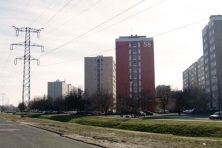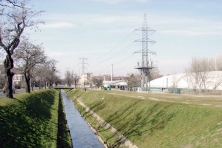Manual Towards a Clumsy City
Budapest (HU) – Runner-up
TEAM DATA
Team Representative: Romain Granoux (FR) – architect; Associate: Margaux Minier (FR) – architectural historian
Contributor: François Justet (FR) – architect
+33 6 87 51 08 27 – info@clumsycity.com – www.clumsycity.com
See the complete listing of portraits here
See the site page here

M. Minier, F. Justet and R. Granoux
INTERVIEW
1. How did you form the team for the competition?
We are two architects and a historian-philosopher motivated by a common will to work together in the long term. We wanted to challenge ourselves on a European urban competition. We wanted to gather our ideas by confronting the disciplines to anchor the project in a theoretical intention and a strong bias of urban representation. And we already knew that we shared the same vision of alternative and sustainable architecture, opened to the others and assuming artistic and written influences.
2. How do you define the main issue of your project, insisting on how you answered on this session main topic: adaptability and urban rhythms?
An adaptable city is a city that understood the transformations of its uses through the analysis of the urban, seasonal, daily and generational rhythms in relationship to determined spaces. To save time, an unrenewable good, we chose to emphasize the mutability character of the city, which could reinvent itself every time it is needed through the diversion of functions and the multiplication of uses by integrating the inhabitants into the making of the city. The ephemeral and the vulnerable define the foundation of our problem and the durability of planning. The stake is to face the unforeseen, to empower the inhabitants and the urban space at the same time. Yet, to insure an autonomous production of the city, we wanted to split up the elements of the project and generate vulnerability: spatial fragmentation and temporal fragmentation. The fragmentation then establishes the premise of a project of urban acupuncture, which also accepts the clumsiness of the proposal.
3. How did this issue and the questions raised by the site mutation meet?
We soon understood the relatively difficult economic environment of the city as well as its ambition to quickly revitalize the site of Rakos by the creation of a green alley, the revalorization of the commercial axis and the organization of transports network; this led us to notice the complexity of housings typologies and we therefore wanted to propose short and long-term solutions that allow adaptation to the intrinsic and extrinsic transformations of the city by directing them and, by extension, foreseeing the changes. Because spontaneous and rationalized planning on various temporalities represents the outbreak of a future change and long-term evolutionary planning. The definition of the adaptability as an “immediate future” therefore inspired us the creation of a manual to design urban planning of repetition; i.e. urban planning that is able, on one hand, to regenerate according to the evolution of needs and, on the other hand, to reproduce itself. Various levels of analysis, typologies and temporalities mix up and overlap to create a totally malleable and reversible “à la carte” town planning. Numerous solutions are proposed, the equations are multiple whether we want to give priority to the landscape, cultural or real estate aspect; the time for reflection being determined by the needs of the inhabitants themselves. We create rhythm, we revitalize places. We provoke exchange and produce coexistence.



4. Have you already treated this issue previously and could you present some reference projects that inspired yours?
Given the fact that our association is relatively new, we have never handled this problem before, except during our respective studies. A few references for the project:
- New York’s High Line, for the idea of urban landscape;
- Decolonization manual from Salotto Buono, for the idea to set up tools;
- The Coloco Collective, for the citizenship intervention;
- Michel Lussault, “L’avènement du monde”, for the reflections on today’s issues;
- Thierry Paquot, for the theorisation of chronotopic urban planning;
- Henri Lefebvre, “Le droit à la ville”, for the participative process;
- Andrea Branzi, “Nouvelles de la métropole froide”;
- Paul Ricœur, “Autonomie et vulnérabilité”;
- Marco Casagrande, for urban acupuncture.
5. Today –within the era of an economic crisis and sustainability– the urban-architectural project should reconsider its production method in time; how did you integrate this issue in your project?
We elaborated a complex and fragmented system of sustainable city and promoted a participative and evolutionary process to spare spirits before converting spaces. The idea –in a constant will to make things vulnerable– refuses the overall drawing; the goal is not æsthetic, it is pragmatic and political. Priority is given to testing the manual before the harmony of shapes and colours. The progressive urban implementation is based on an enlightened pragmatism and not on a fixed æstheticized image of the city. If Budapest takes its time to build its future, it also wants to see the immediate effects of a participative and open concept. What characterizes the manual is that it multiplies the possibilities while refusing the utopias. It is the creation of realistic and tolerant “à la carte” urban planning. This empirical approach within the depths of daily realities reveals the premises of a humble and manifest architecture. We defend the idea of a powerful and clumsy city. We refuse outrageous policies and want to build unique schemes without imposing them, let things relate to each other by themselves, just let things be and somehow be “benevolent”. To weaken the elements of a whole is to make the whole stronger. It is to making mutations possible, planning certain obsolescence, building adaptability. Unlike René Char who defines poetry by its invulnerability, we make vulnerability the genesis of a poetic city.
6. Is it the first time you have been awarded a prize at Europan? How could this help you in your professional career?
It is the first time. And we plan to take advantage of this opportunity to first involve in the implementation of the project in association with the city, the partner team and the inhabitants, to further develop the manifesto of a clumsy city through advanced communication, and maybe to also think of the association of our ideas within the framework of other competitions and calls for projects. This is only the beginning…